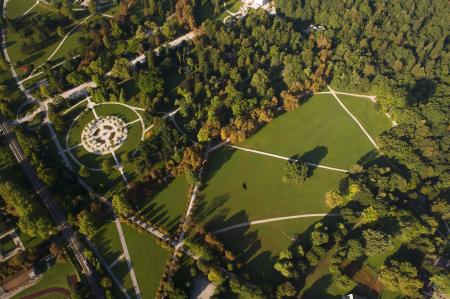
Area characterisation:
Biogeographic region: Continental/Alpine
Surface area: 459 ha
Country: Slovenia
Region/Province: Slovenia
Landscape park Tivoli, Rožnik and Šiška hill is located in the City of Ljubljana, practically in the city centre itself. This nature protected area has a rich history of being a public urban park enhancing health and well-being of citizens and visitors.
Mostly covered by forested area, the Landscape Park comprises a mosaic of different landcover types, forest, public urban park, agricultural land and wetlands, including two relatively big ponds. The recreation area is rich in biodiversity. The area was first protected in 1984, when the then local authorities designated the area a Natural Site of Special Interest in order to conserve numerous natural values and landscape diversity in the heart of an urban area.
In 2015, the Municipality of Ljubljana drafted a new ordinance in order to conserve numerous natural values, extraordinary biodiversity, and the landscape diversity of the area.
Objective:
The Landscape park Tivoli, Rožnik and Šiška hill aims to enhance health and well-being of citizens and visitors while conserving natural values and landscape diversity.
The urban green infrastructure of the Landscape Park area further aims to regulate the urban micro-climate, improving air quality and reducing run-off.
Financing:
City, regional general funds:
City budget to cover the cost of the salaries to carry out the yearly programme.
International funds:
Project funds – grant of the Parks Dinarides (WWF)
Actions:
PRINCIPLE UF-NbS (Urban Forests as Nature-Based Solutions) ACTION(S)
- Strong visual and landscape amenity
- Helps regulate the urban climate and has a mitigating effect on climate change
- Regulates urban air quality
- Intercepts rainfall and slows water run-off
- Is a key element in nutrient cycling
- A source of renewable produce
- Is a key setting for tourism, recreation, sports training, children’s play and part of an active, healthy lifestyle
- Provides extensive health benefits
- Provides connectivity and links important green areas together
Organisations:
1. Governing authorities: Municipality of Ljubljana, Ministry for the Environment and Spatial Planning
2. Associations: Fishing Associations Barje and Dolomiti, DOPPS - Birdlife Slovenia, Botanical Society of Slovenia, The Slovenian association for bat research and conservation, Slovenian Butterfly Research and Conservation Society, WWF Adria, Slovenian Society of Plant Biology, Societas herpetologica Slovenica, Biology Students Association, Slovenian Association of Landscape Architects;
3. Citizens: Park users, land owners, property owners,
4. Municipalities: Municipality of Ljubljana
5. Public/private institutions: Public institutions: Office of Urban Planning; City counsellors; Municipalities of local interest; University of Milan, University of Bari A. Moro; Private: Cariplo (bank) Foundation
6. Park planner and authorities: Planner: LP TRŠh Management Unit; Authorities: Dept. for protection of the environment of MOL, Institute of RS for Nature Protection, steering committee;
7. Technicians for park maintenance/monitoring and to educate and support citizens: JP VOKA SNAGA d.o.o., Tisa d.o.o. (arborists), forest and agricultural land owners
Contacts:
Andrej Verlič
JAVNO PODJETJE VODOVOD KANALIZACIJA SNAGA d.o.o.
Head of Nature Protection Unit
Sector for public space maintenance - Landscape park Tivoli, Rožnik and Šiška hill management unit
Vodovodna cesta 90, SI - 1000 Ljubljana
T +386 (1) 4779 792
M +386 (40) 512 195
E andrej.verlic@vokasnaga.si
W www.vokasnaga.si
Global goals:
-
3. Good Health and well being
-
11. Sustainable cities and communities
NBS goals:
- Enhancing sustainable urbanization
- Restoring ecosystems and their functions
- Urban regeneration through nature-based solutions
- Nature-based solutions for improving well-being in urban areas
NBS benefits:
- Increasing infiltration
- Reduce run-off
- Reducing temperature at meso or micro scale
- Greater ecological connectivity across urban regenerated sites
- Increased cultural richness and biodiversity
- Improve air quality
- Increase amount of green open spaces for residents
- Increase well-being
- Provision of health benefits
Further information:
The compilation of this case study description has been funded by the Horizon 2020 CLEARING HOUSE project. This project has received funding from the European Union’s Horizon 2020 research and innovation programme under grant agreement No 821242.